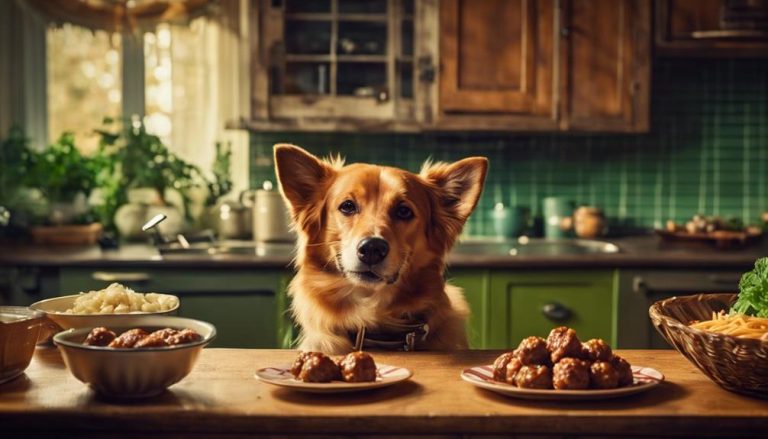Dogs and Meatballs: Safety Tips
Dogs can enjoy meatballs if they’re made the right way. Homemade meatballs are the best choice because you can make sure they don’t have anything bad for your dog, like onions, garlic, or too much salt, which are often found in the ones you buy from stores. It’s good to use lean meat and keep an eye on how much and how often your dog eats them to avoid weight issues and stomach problems.
Cooking methods and the size of the meatballs should be adjusted based on the size of your dog to prevent choking. Knowing which ingredients are healthy and what alternatives to use can help keep your dog healthy. If you’re looking to make sure your dog’s diet is beneficial, looking up some guidelines and recipes is a smart move.
Key Takeaways
- Lean meat homemade meatballs are safe for dogs, avoiding onions and garlic.
- Avoid store-bought meatballs due to high salt and unsafe seasonings.
- Ensure small portions to prevent choking in dogs.
Understanding Meatballs for Dogs
When thinking about adding meatballs to your dog’s diet, it’s key to remember that while they can be a good protein source when made from lean meats such as chicken or beef, how they’re made really matters for your dog’s health.
Making meatballs at home lets you make sure they don’t have anything bad for dogs like onions and garlic, which could harm them. On the other hand, meatballs you buy from the store often have these ingredients and too much salt, which can be dangerous for your dog.
Safe Ingredients for Homemade Meatballs
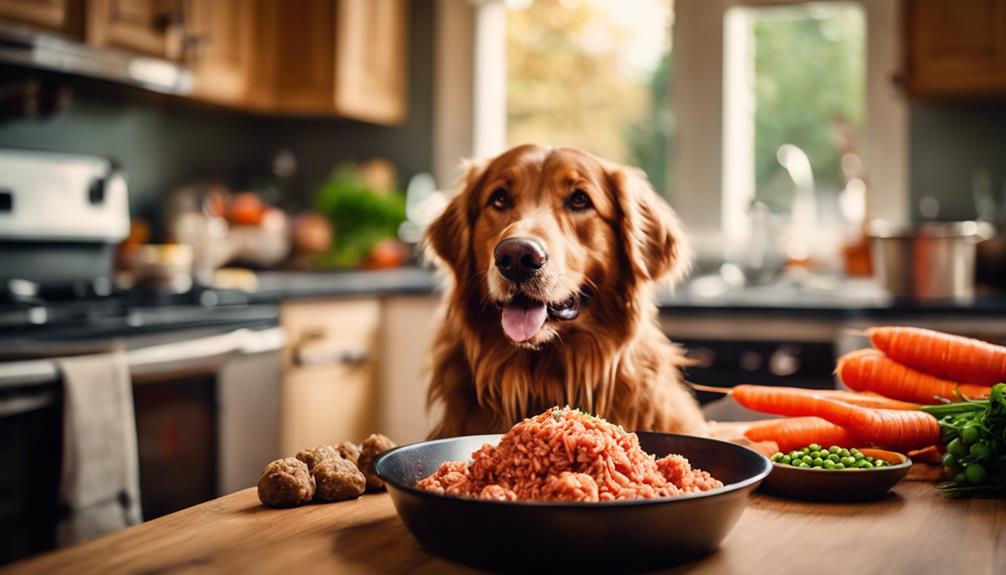
Choosing the right ingredients for homemade meatballs is crucial, especially when making them for dogs. Opt for lean ground meats such as chicken, beef, or turkey to ensure the treats are both nutritious and safe. Adding breadcrumbs and a bit of cheese not only makes the meatballs tastier but also adds essential nutrients, making them a healthier option for your pet.
When you prepare meatballs at home, you have full control over what goes into them. This means you can avoid any harmful additives and focus on including only safe, nutritious ingredients. This careful selection helps support your dog’s health, making homemade meatballs a delicious and beneficial part of their diet.
The Risks of Store-Bought Meatballs
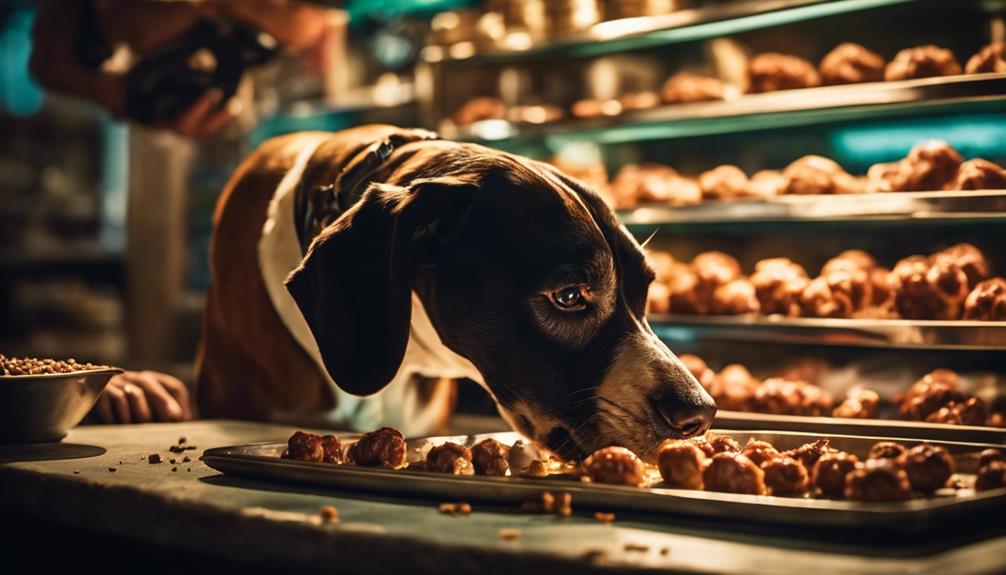
Store-bought meatballs might seem like an easy treat for your dog, but they can actually be quite dangerous. These meatballs often contain onions and garlic, which are toxic to dogs and can cause stomach issues or even more serious conditions like anemia.
They’re also usually high in sodium, which isn’t good for your dog and can lead to symptoms of salt poisoning, such as vomiting, diarrhea, increased thirst, and urination. In severe cases, it can even cause neurological issues.
The sauces that come with these meatballs might also have harmful ingredients, making the risks even higher. Considering your dog’s health, it’s clear that the quick solution of store-bought meatballs isn’t worth the potential problems.
Portion Size and Frequency
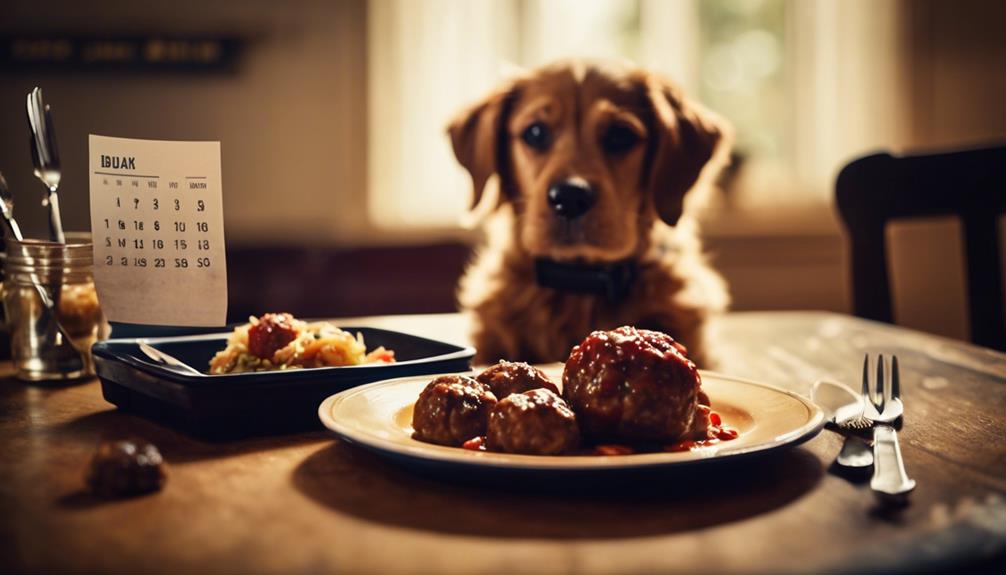
Knowing the right portion size and how often you should give meatballs to your dogs is key to keeping them healthy and avoiding nutritional issues. Treats like meatballs should be given sparingly, considering the dog’s size and dietary requirements. Giving too many can lead to weight gain and other health problems, so it’s wise to ask a vet for advice.
| Dog Size | Recommended Portion Size | Frequency |
|---|---|---|
| Small | 1 small meatball | Once a week |
| Medium | 2 small meatballs | Once a week |
| Large | 3 small meatballs | Once a week |
It’s important to limit how often dogs eat meatballs to avoid health issues. Following these recommendations makes meatballs a safe and fun treat for dogs.
Lean Meats: Best Choices
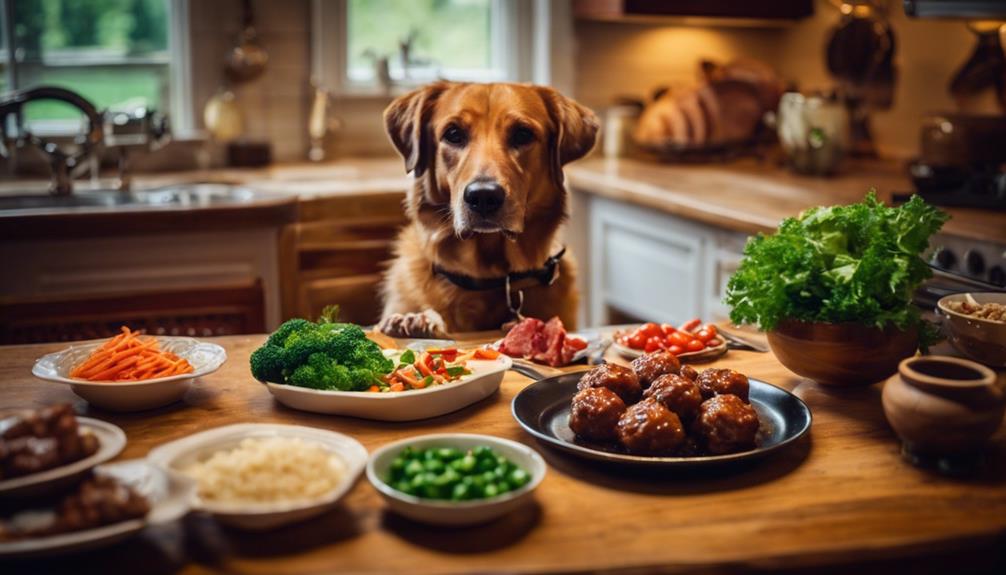
When making homemade meatballs for your dog, it’s key to pick the right meat. Lean meats like chicken, lean beef, and turkey are the best choices. These options are packed with proteins that are good for your dog but don’t have too much fat or any harmful additives. This choice helps avoid overweight issues and digestive problems in dogs, making their diet healthier.
Choosing lean meats for your dog’s treats means they get all the nutrients without the bad stuff. It makes sure your dog stays fit and has an easier time digesting their food. Keeping treats lean and healthy is a simple way to look after your dog’s overall well-being.
Toxic Ingredients to Avoid
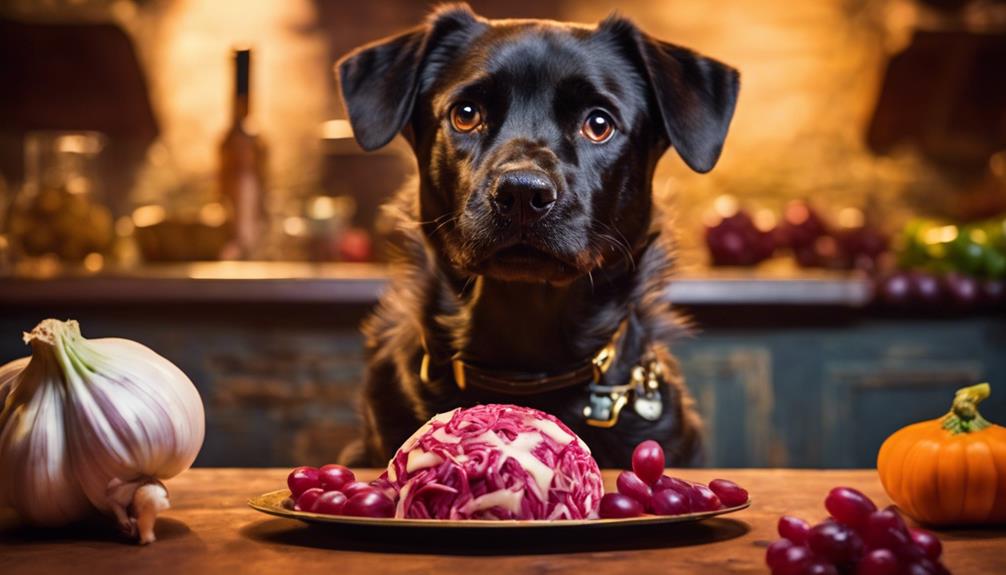
When making meatballs for dogs, it’s crucial to skip certain ingredients that could harm them. Dogs can’t handle onions and garlic because they have substances that harm their red blood cells, which could lead to serious health issues. Also, too much salt is bad for dogs and can cause sodium toxicity. Always check the ingredients carefully before adding them to your dog’s food.
| Harmful Ingredient | Why It’s Bad |
|---|---|
| Onions and Garlic | Harmful to red blood cells |
| Garlic and Onion Powders | Even more dangerous in small amounts |
| High Salt Content | Can cause sodium toxicity |
This table shows the dangerous ingredients in meatballs for dogs, underlining the need for careful ingredient choice.
When preparing meals for your dog, it’s not just about avoiding harmful ingredients. It’s about ensuring their overall health and happiness. Remember, when in doubt, consult with a vet to make sure your dog is getting the nutrition they need without the risk.
Signs of Gastrointestinal Distress
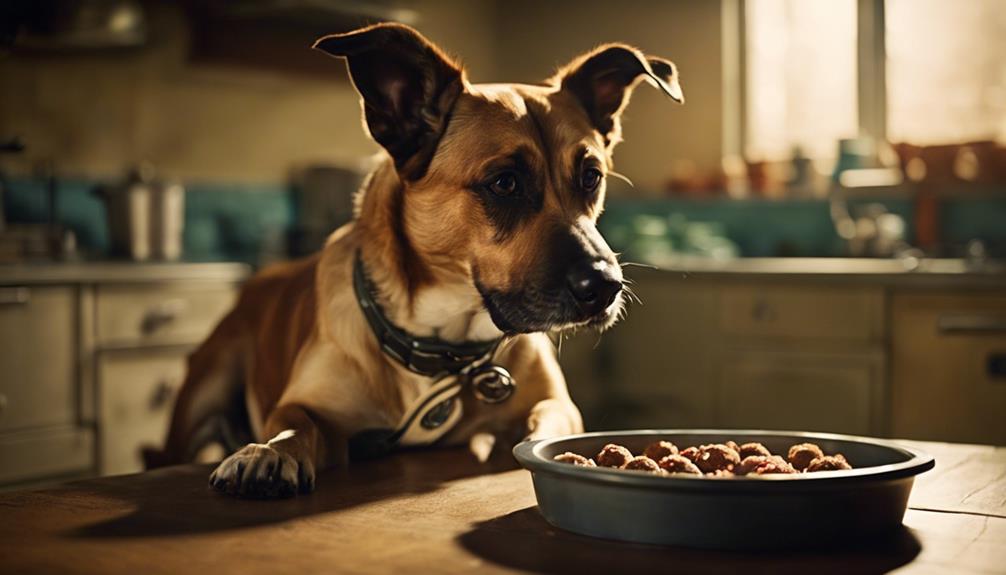
After ensuring meatballs don’t contain anything harmful, noticing if your dog shows signs of digestive upset is crucial. Vomiting and diarrhea are clear signals that the meatballs might not sit well with your dog’s stomach. These issues can start as minor problems but could lead to serious health concerns if ignored.
Along with these symptoms, a dog might also become very tired, showing that their body is working hard to combat the digestive trouble. Shaking or tremors are serious signs that the meatballs have caused a significant problem. Pet owners should watch out for these signs after their dog eats meatballs to ensure they can act quickly if needed.
Homemade Meatball Recipe Tips
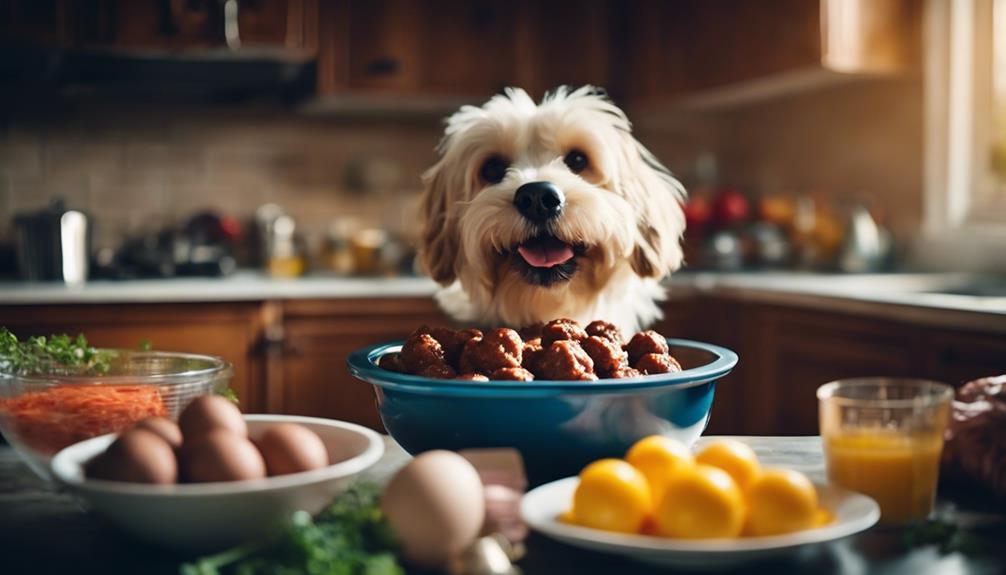
When making meatballs for your dog, it’s critical to choose the right ingredients to ensure they’re both nutritious and safe.
The way you cook them also matters because it affects how easy they are for your dog to digest and how well the nutrients are preserved.
Plus, you should consider your dog’s size and eating habits when deciding how big to make the meatballs. This helps prevent choking and makes it easier for them to digest their food.
Choosing Healthy Ingredients
Choosing the right ingredients for your dog’s homemade meatballs is key to their health and safety. When making these treats, it’s crucial to pick items that will benefit your dog. Lean ground meats like chicken or beef are great choices because they’re packed with protein but low in fat. Adding grated vegetables such as carrots can also boost the nutritional value, providing fiber and essential vitamins.
It’s just as important to know what to leave out. Onions, garlic, and too much salt can be harmful to dogs, so avoid these to keep your meatballs safe for your pet. Making your own meatballs gives you control over what your dog eats, ensuring they stay away from raw or dangerous ingredients. This approach allows you to cater specifically to your dog’s dietary needs, making mealtime both enjoyable and healthy.
Cooking Techniques Matter
Choosing the right ingredients for your dog’s meatballs is crucial for their health. It’s just as important to pay attention to how you cook them.
You should use lean ground meat like beef, chicken, or turkey to keep the meatballs low in fat and high in protein. Adding grated vegetables such as carrots or zucchini can boost the meatballs’ nutritional value by adding vitamins and fiber without extra calories or unhealthy additives.
The way you cook these meatballs makes a big difference in how healthy they are. Baking or boiling them instead of frying cuts down on fat, making them a better choice for your dog.
Meatball Size and Dogs
When making homemade meatballs for your dog, it’s crucial to consider the size of the meatballs. This ensures they’re a safe treat for your pet, taking into account their breed, how strong their jaw is, and how well they can chew. This helps prevent any choking risks and makes sure they can enjoy their snack safely.
Customize the size of the meatballs based on your dog’s breed, how much they weigh, and their usual chewing behavior. This is key to avoiding any choking hazards. You should also match the meatball size to your dog’s jaw strength, ensuring they can chew the meatballs properly without any trouble.
Remember, different dogs might need meatballs of various sizes to eat them safely. For training purposes or as a special treat, small, easily chewable pieces are ideal. It’s also important to make meatballs that don’t contain anything that could harm your dog, offering them a healthy treat.
Alternatives to Meatballs
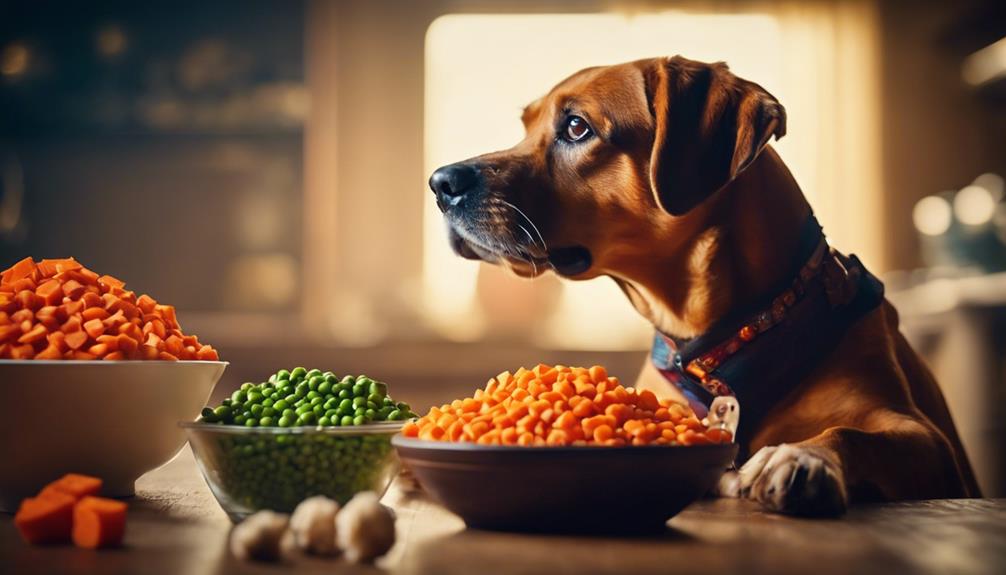
Pet owners looking for healthy treats for their dogs might consider making their own meatballs. These homemade versions can be made with lean ground meat and include grated vegetables to pack in nutrients. This method ensures dogs get the essential nutrients they need while avoiding the high-fat content and dangerous additives found in some commercial treats.
Making your own dog treats also lets you control the ingredients, cutting out excessive salt and harmful seasonings. You can use plain cooked meat or mix it with oats and an egg to make the treats both nutritious and tasty. These meatball treats are not just snacks but can also be great for training, offering a nutritious reward for your dog.
Monitoring Your Dogs Health
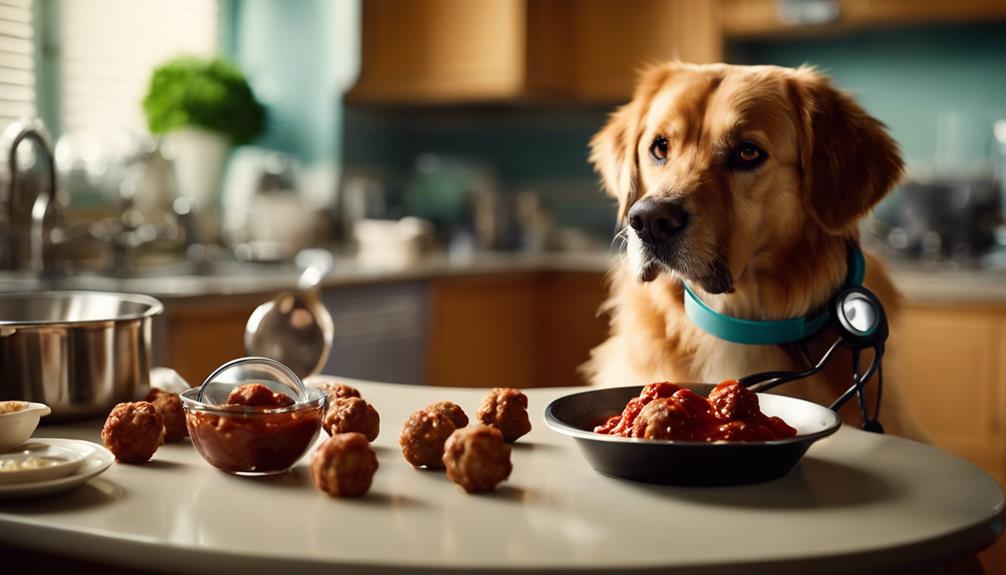
Keeping an eye on your dog’s health after they’ve had meatballs is crucial for their overall wellness. Noticing any issues like stomach upset or signs of poisoning from onions and garlic early on can help avoid bigger problems later.
Making sure they see the vet regularly ensures that any negative reactions are caught and dealt with quickly, keeping your pet safe.
Spotting Health Issues
Keep a close eye on your dog after they’ve eaten meatballs to catch any signs of stomach upset early. Acting quickly when you notice these symptoms can help avoid more serious health problems for your pet.
- Vomiting: If your dog starts throwing up soon after eating, it might even have streaks of blood. This is a serious sign that there could be damage or bleeding in their gut.
- Diarrhea: If your dog has ongoing diarrhea, it suggests they’re not reacting well internally, possibly due to harmful ingredients.
- Lethargy: A sudden drop in energy or interest is often a sign your dog isn’t feeling well.
- Tremors: If your dog starts shaking uncontrollably, it could mean they’re having a bad reaction to something toxic in the food.
- Delayed Symptoms: Remember, symptoms from toxic ingredients like onions or garlic might not show up immediately.
If your dog shows any of these worrying signs after eating meatballs, getting them to a vet quickly is crucial.
Regular Vet Visits
Monitoring your dog’s reaction to meatballs is just one part of keeping them healthy, which highlights why visits to the vet are so necessary. These appointments let a vet check your dog from nose to tail, spotting health issues early and advising on preventive measures. They’re key for catching conditions like hypertension before they become bigger problems.
| Aspect | Benefit | Frequency |
|---|---|---|
| Health Inspection | Finds early illness signs | Once a Year |
| Teeth Maintenance | Stops dental problems | Every Six Months |
| Diet Tips | Recommends the best food | When Required |
| Shots | Fights off sickness | Following Vet’s Schedule |
Sticking to your vet’s advice and keeping up with these visits can seriously improve your dog’s life. Regular check-ups can catch problems like dental issues before they escalate and ensure your dog is eating right. Plus, staying on top of vaccinations keeps serious diseases at bay.
Frequently Asked Questions
Are Meatballs Safe for Dogs?
- Meatballs can be dog-safe with right ingredients.
- Skip garlic and onion, choose lean meats.
- Homemade meatballs are usually safer for dogs.
Can Dogs Eat Meatballs With Garlic Powder?
- Avoid garlic in dog meals to prevent health risks.
- Choose safe alternatives for your dog’s diet.
- Garlic can cause anemia in dogs, so steer clear.
Can Dogs Eat Meatballs With BBQ Sauce?
- Avoid BBQ sauce in dog’s meatballs; it’s unsafe.
- Choose plain meatballs for your pet’s meal.
- Garlic and onions in sauces can harm dogs.
Is It Safe for Dogs to Eat Spaghetti?
- Plain pasta is safe but lacks nutrients for dogs.
- Sauces can have toxic ingredients like garlic.
- Always choose simple, cooked spaghetti for your pet.

